雅思基础阅读
- 格式:doc
- 大小:49.00 KB
- 文档页数:16
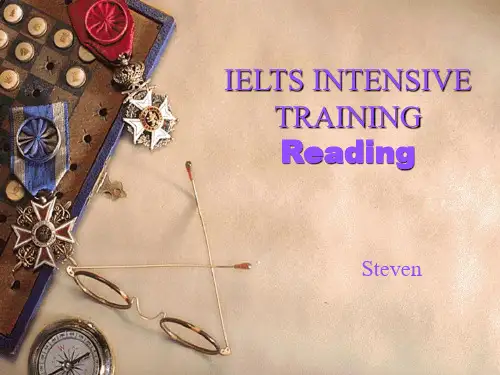
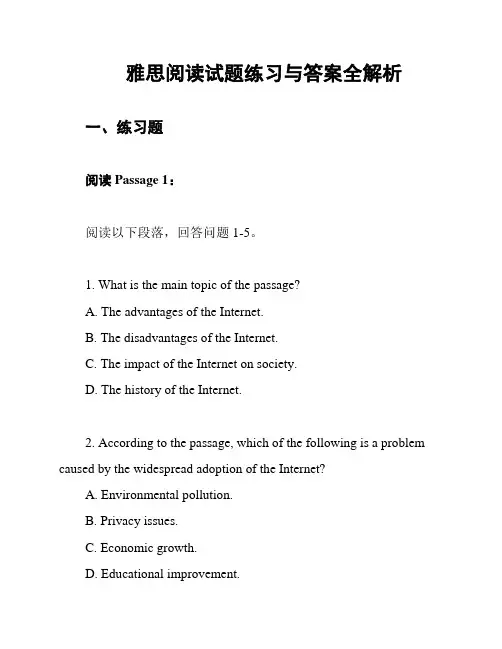
雅思阅读试题练习与答案全解析一、练习题阅读Passage 1:阅读以下段落,回答问题1-5。
1. What is the main topic of the passage?A. The advantages of the Internet.B. The disadvantages of the Internet.C. The impact of the Internet on society.D. The history of the Internet.2. According to the passage, which of the following is a problem caused by the widespread adoption of the Internet?A. Environmental pollution.B. Privacy issues.C. Economic growth.D. Educational improvement.3. Why does the Internet lead to social isolation?A.因为它改变了人们的交流方式B.因为它使人们更容易获取信息C.因为它促进了全球连接D.因为它提供了更多的娱乐方式4. Which of the following is NOT mentioned in the passage?A. Privacy issues.B. The spread of misinformation.C. Social isolation.D. Education inequality.5. In the author's opinion, how should people use the Internet responsibly?A. They should limit their online activities to protect their privacy.B. They should only consume information from trusted sources.C. They should spend more time on social media to stay connected.D. They should use the Internet as an educational tool to enhance their knowledge.阅读Passage 2:阅读以下段落,回答问题6-10。
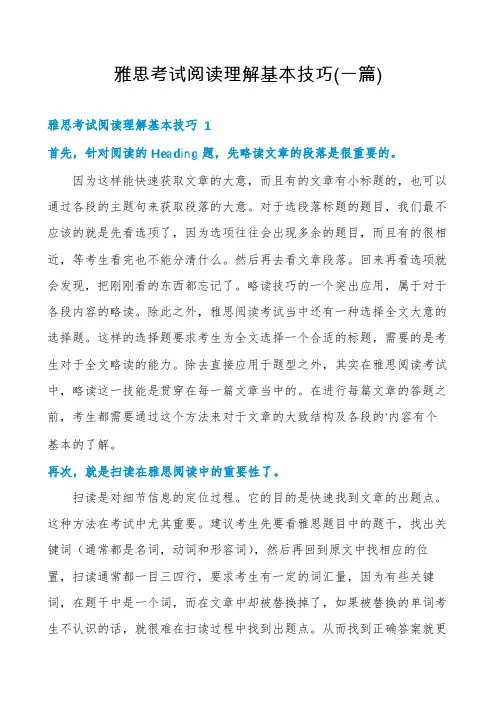
雅思考试阅读理解基本技巧(一篇)雅思考试阅读理解基本技巧 1首先,针对阅读的Heading题,先略读文章的段落是很重要的。
因为这样能快速获取文章的大意,而且有的文章有小标题的,也可以通过各段的主题句来获取段落的大意。
对于选段落标题的题目,我们最不应该的就是先看选项了,因为选项往往会出现多余的题目,而且有的很相近,等考生看完也不能分清什么。
然后再去看文章段落。
回来再看选项就会发现,把刚刚看的东西都忘记了。
略读技巧的一个突出应用,属于对于各段内容的略读。
除此之外,雅思阅读考试当中还有一种选择全文大意的选择题。
这样的选择题要求考生为全文选择一个合适的标题,需要的是考生对于全文略读的能力。
除去直接应用于题型之外,其实在雅思阅读考试中,略读这一技能是贯穿在每一篇文章当中的。
在进行每篇文章的答题之前,考生都需要通过这个方法来对于文章的大致结构及各段的'内容有个基本的了解。
再次,就是扫读在雅思阅读中的重要性了。
扫读是对细节信息的定位过程。
它的目的是快速找到文章的出题点。
这种方法在考试中尤其重要。
建议考生先要看雅思题目中的题干,找出关键词(通常都是名词,动词和形容词),然后再回到原文中找相应的位置,扫读通常都一目三四行,要求考生有一定的词汇量,因为有些关键词,在题干中是一个词,而在文章中却被替换掉了,如果被替换的单词考生不认识的话,就很难在扫读过程中找到出题点。
从而找到正确答案就更困难了。
我们从题干入手找题目中的定位词,忽略与题目要求不相关的信息,然后回到原文迅速找到定位词所在的地方,即答案可能出现的地方。
最合适的定位词最好是形式稳定且比较容易被扫到。
比如说,雅思阅读定位词有人名、地名、机构名称等,还有数词、特殊印刷字体的词,建议考生遇到这些词的时候一定要用笔把它们画出来,这样在做题的时候找定位词就容易多了。
掌握了上面两种方法之后,就要看考生的词汇量和语法的掌握程度了。
因为雅思阅读是精读和泛读相结合的。
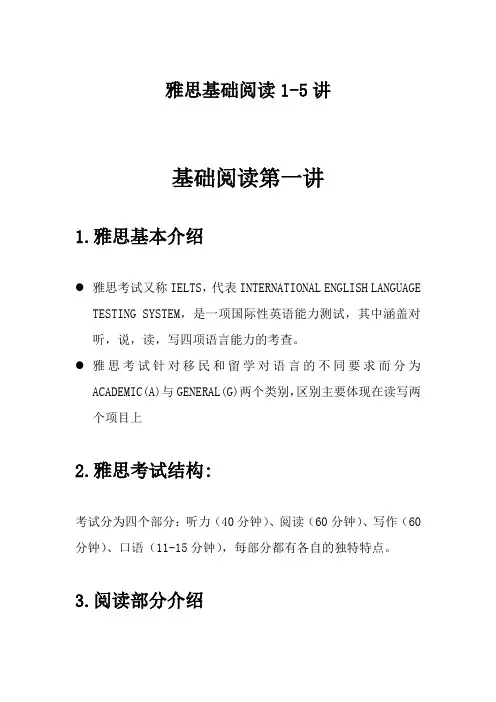
雅思基础阅读1-5讲基础阅读第一讲1.雅思基本介绍●雅思考试又称IELTS,代表INTERNATIONAL ENGLISH LANGUAGETESTING SYSTEM,是一项国际性英语能力测试,其中涵盖对听,说,读,写四项语言能力的考查。
●雅思考试针对移民和留学对语言的不同要求而分为ACADEMIC(A)与GENERAL(G)两个类别,区别主要体现在读写两个项目上2.雅思考试结构:考试分为四个部分:听力(40分钟)、阅读(60分钟)、写作(60分钟)、口语(11-15分钟),每部分都有各自的独特特点。
3.阅读部分介绍阅读考试是雅思考试的第二项,时长60分钟,考查40个题目。
●A类阅读设置3篇阅读材料,每篇800-1200字,7-9段,取自杂志,学术期刊,报纸,或书籍.题材广泛,涵盖人文、社科、技术等领域,但并不要求考生对文章内容有专业性的了解.学术类考试的三篇文章中,至少有一篇包含有详细的逻辑论证,可能有一篇文章附带有图解、统计表、曲线图等各式图表。
考试内容和测试角度对中国考生的单词量和阅读能力提出较高要求,一般要求考生至少掌握6000以上词汇。
●G阅读考试时间为60分钟,共40道题,分为三部分,难度递增。
第一部分考日常事务(social survival),主要包含与生活密切相关的实用文本,要求考生能够定位和辨别一般事实性信息。
一般为两篇文章,每篇文章各有一种题型。
第二部分考培训内容(training survival),一般与某种语言类或实用类短期或长期培训有关,与第一部分相比,语言稍复杂一些,表达法更多样。
一般考两篇文章,各一种题型。
第三部分为一般的说明文(general reading),题材广泛,篇幅较长,议论文一般不在考试之列。
考一篇文章,题型在三四种左右。
●评分标准4.雅思阅读常见题型第一梯队:●True/False/Not Given●Matching●Summary●List of headings●Multiple choice questions第二梯队:●Short-answer question●Sentence completion●Table completionFlow chartLabeling a diagram5. 雅思阅读考察重点●Recognize the topic and the main idea of the text (the titles, headings, the caption diagram, the tables )P9 P12 P15 16●Recognize the key wordsP6~P9Try to explain the word by its synonyms Principle/principal, simulate/stimulate stationary/stationery,attitude/aptitude/altitude●Summarize the paragraphs idea and understand the relation between the paragraph topic and supporting argumentsP15●By using the link words and grammar knowledge to identify the structure of sentences整个过程其实就是区分主题和剥离修饰成分的过程。
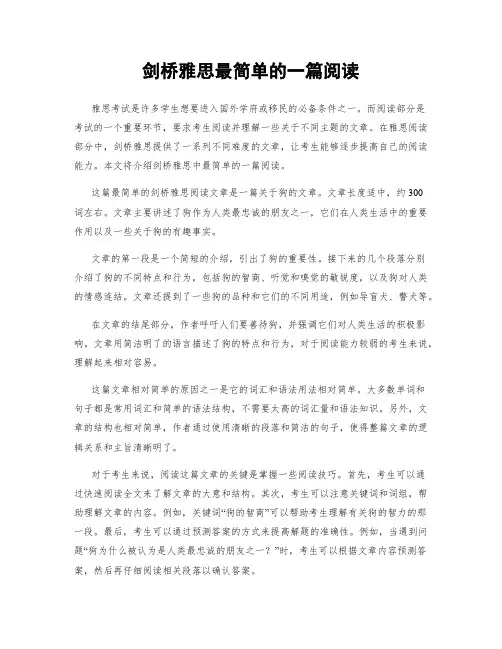
剑桥雅思最简单的一篇阅读雅思考试是许多学生想要进入国外学府或移民的必备条件之一。
而阅读部分是考试的一个重要环节,要求考生阅读并理解一些关于不同主题的文章。
在雅思阅读部分中,剑桥雅思提供了一系列不同难度的文章,让考生能够逐步提高自己的阅读能力。
本文将介绍剑桥雅思中最简单的一篇阅读。
这篇最简单的剑桥雅思阅读文章是一篇关于狗的文章。
文章长度适中,约300词左右。
文章主要讲述了狗作为人类最忠诚的朋友之一,它们在人类生活中的重要作用以及一些关于狗的有趣事实。
文章的第一段是一个简短的介绍,引出了狗的重要性。
接下来的几个段落分别介绍了狗的不同特点和行为,包括狗的智商、听觉和嗅觉的敏锐度,以及狗对人类的情感连结。
文章还提到了一些狗的品种和它们的不同用途,例如导盲犬、警犬等。
在文章的结尾部分,作者呼吁人们要善待狗,并强调它们对人类生活的积极影响。
文章用简洁明了的语言描述了狗的特点和行为,对于阅读能力较弱的考生来说,理解起来相对容易。
这篇文章相对简单的原因之一是它的词汇和语法用法相对简单。
大多数单词和句子都是常用词汇和简单的语法结构,不需要太高的词汇量和语法知识。
另外,文章的结构也相对简单,作者通过使用清晰的段落和简洁的句子,使得整篇文章的逻辑关系和主旨清晰明了。
对于考生来说,阅读这篇文章的关键是掌握一些阅读技巧。
首先,考生可以通过快速阅读全文来了解文章的大意和结构。
其次,考生可以注意关键词和词组,帮助理解文章的内容。
例如,关键词“狗的智商”可以帮助考生理解有关狗的智力的那一段。
最后,考生可以通过预测答案的方式来提高解题的准确性。
例如,当遇到问题“狗为什么被认为是人类最忠诚的朋友之一?”时,考生可以根据文章内容预测答案,然后再仔细阅读相关段落以确认答案。
总之,这篇剑桥雅思阅读中最简单的一篇文章涉及到了狗的特点和作用,语言简单易懂,词汇和语法相对简单,结构清晰。
考生可以通过掌握一些阅读技巧来更好地理解和回答相关问题。
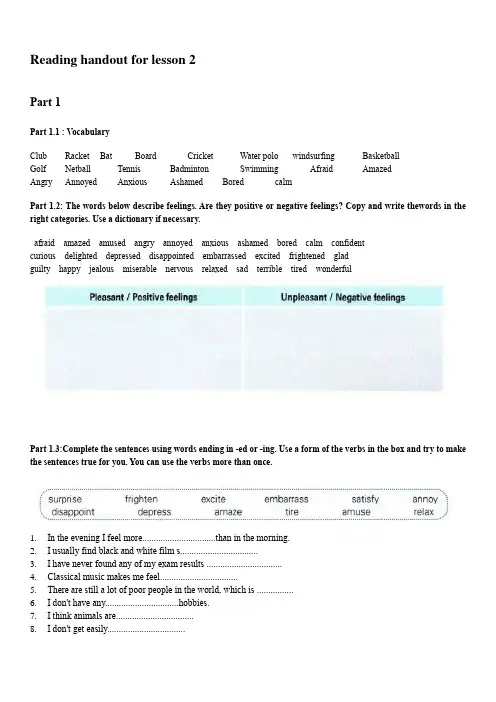
Reading handout for lesson 2Part 1Part 1.1 : VocabularyClub Racket Bat Board Cricket Water polo windsurfing BasketballGolf Netball Tennis Badminton Swimming Afraid AmazedAngry Annoyed Anxious Ashamed Bored calmPart 1.2: The words below describe feelings. Are they positive or negative feelings? Copy and write thewords in the right categories. Use a dictionary if necessary.afraid amazed amused angry annoyed anxious ashamed bored calm confidentcurious delighted depressed disappointed embarrassed excited frightened gladguilty happy jealous miserable nervous relaxed sad terrible tired wonderfulPart 1.3:Complete the sentences using words ending in -ed or -ing. Use a form of the verbs in the box and try to make the sentences true for you. You can use the verbs more than once.1.In the evening I feel more................................than in the morning.2.I usually find black and white film s..................................3.I have never found any of my exam results .................................4.Classical music makes me feel..................................5.There are still a lot of poor people in the world, which is ................6.I don't have any................................hobbies.7.I think animals are..................................8.I don't get easily..................................Part 2:Reading Practicee the organization of the text to help you. Look at the text quickly to decide which paragraph(s) you would need to read properly if you only wanted to find out about the reasons why people choose to study abroad.Paragraph number(s): ..............................2.Scan the text to find names of countries, people and organizations. Copy and complete the table.3.Do this exercise in less than one minute if you can. First copy the table in your notebook. Then scan the text for the different items. Check in the Answer key to see if you found them4.Scan the text quickly to answer the following questions.1 Which paragraph(s) give(s) somebody's opinion?2 What does somebody really want people to understand?3 Which two paragraphs talk about the country that is the most welcoming to overseasstudents?4 Which paragraph gives examples to explain what an internationalization approach is?Is it better to go abroad to study?Student-friendly placesThe British Council has named the universities that are most welcoming to overseas students. As you would expect, English-speaking countries such as Australia, the UK and the US have made the top 10, but the number one may be a surprise: Germany. Two Far Eastern countries, i.e. China and Malaysia, made it to the top 5, ranking higher than the US, Japan, Russia, Nigeria and Brazil.The benefits of studying abroadRussell Howe, a Scot who is currently studying a Business degree at Stellinga International College in the Netherlands, previously also studied in India (which came 11th on the list). 'People often ask me why I needed to travel, because British universities have a good reputation elsewhere in the world. But this is not something I needed to do, but something I really wanted to do. I have learnt different ways of looking at things, but I also found out how much we all have in common, wherever we are from. All of this will be useful in my future career.'Russell is not the only international student in his department. Business and administrative courses are the most popular with international students, followed by engineering and technology, social studies, creative arts and design, medicine-related topics and law. Manal, a student at the Faculty of Art and Design at Stellinga, says she has similar reasons to Russell, but there is more: 'I wanted to broaden my understanding of the world. I have enhanced my language skills: I am more fluent inEnglish and have also taken a level 1 Dutch evening class. One of my modules is about European art, and I believe that I am benefiting more from studying this in Europe than anywhere else. I have managed to visit other countries in my holidays, and really feel that this whole experience is developing my global perspective. I also hope that I have made lasting friendships and contacts.'Enabling student accessWhat is it that makes these countries student-friendly? Well, all of them make it easy for international students to apply, and provide ongoing support once they are there. They also offer good quality degrees, which are valued highly in other countries too. The fact that Germany came out as winner is probably due to the country's efforts towards internationalization. One aspect of this is that the country welcomes foreign students by charging them the same fees as home students, meaning that in some universities overseas students study for free. Many classes are conducted in English, and so are most leaflets, making it easier for international students to keep informed and take part in student life. Apart from the financial reasons already mentioned, this type of educational internationalization can help with the quality of research in these universities, through e.g. networking, team work and the sharing of skills. For students, it is a valuable addition to their skills and experience at a time when jobs are not easy to find.Part 3: HomeworkQuestions 1-11Using NO MORE THAN TWO WORDS from the passage for each answer, complete the table and the flow chart below.The required documents:The online application process for people outside the EU:Applying to StellingaCollegeWhy Stellinga?Thank you for your interest in Stellinga International College. As an international student, we are sure you will find our university college an exciting place to study, with like-minded and ambitious individuals.Preparing and submitting your applicationWe have tried to make the application process as easy as possible for you, but there are a number of procedures you must follow.All our courses are taught in English, so first of all you will probably need to submit proof of your English language ability. We require an IELTS score of 6.5 or another test result which is equivalent (see appendix). You will also have to send us your secondary school diploma, so that we can evaluate it. If you have the International Baccalaureate or a DutchVWO diploma, you don't need to provide English language test results.We will also require a personal statement. This is a text of up to 1000 words in which you introduce yourself, explain your interest in our college, and why you want to study your chosen course.If you are from outside the European Union (EU), it is important that you have an entrance visa before you come to study in the Netherlands, but we will apply for this for you.We now only accept online applications, so please ensure that you have all your documents ready to upload before you begin. Any documents that are not in English originally will also need to be translated andthe translations also uploaded. You will need a passport photograph; a copy of your passport; copies of all your certificates, diplomas, etc.; your proof of language ability (see above); and your personal statement in English.What happens next?Your application will then be considered. If your initial application is successful, you will be invited for an interview. This will be conducted in English via Skype, over the phone or on site, depending on whether you can come and visit us. You will talk to two or three members of staff for up to 30 minutes, and will be asked to elaborate on your application documents and your personal statement. We aim to inform you of our decision in writing, within 4 weeks. There are several possible outcomes: you may not have been successful; you may be offered a place at the college or you may be offered a place on the waiting list. You will need to reply to any offers within two weeks, otherwise your place may be offered tosomebody else.Good luck with your application.。
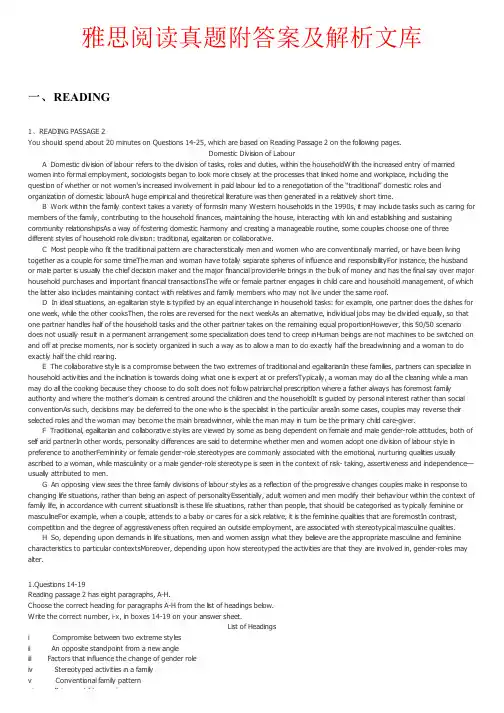
雅思阅读真题附答案及解析文库一、READING1、READING PASSAGE 2You should spend about 20 minutes on Questions 14-25, which are based on Reading Passage 2 on the following pages.Domestic Division of Labour A Domestic division of labour refers to the division of tasks, roles and duties, within the householdWith the increased entry of married women into formal employment, sociologists began to look more closely at the processes that linked home and workplace, including the question of whether or not women's increased involvement in paid labour led to a renegotiation of the “traditional” domestic roles and organization of domestic labourA huge empirical and theoretical literature was then generated in a relatively short time. B Work within the family context takes a variety of formsIn many Western households in the 1990s, it may include tasks such as caring for members of the family, contributing to the household finances, maintaining the house, interacting with kin and establishing and sustaining community relationshipsAs a way of fostering domestic harmony and creating a manageable routine, some couples choose one of three different styles of household role division: traditional, egalitarian or collaborative. C Most people who fit the traditional pattern are characteristically men and women who are conventionally married, or have been living together as a couple for some timeThe man and woman have totally separate spheres of influence and responsibilityFor instance, the husband or male parter is usually the chief decision maker and the major financial providerHe brings in the bulk of money and has the final say over major household purchases and important financial transactionsThe wife or female partner engages in child care and household management, of which the latter also includes maintaining contact with relatives and family members who may not live under the same roof. D In ideal situations, an egalitarian style is typified by an equal interchange in household tasks: for example, one partner does the dishes for one week, while the other cooksThen, the roles are reversed for the next weekAs an alternative, individual jobs may be divided equally, so that one partner handles half of the household tasks and the other partner takes on the remaining equal proportionHowever, this 50/50 scenario does not usually result in a permanent arrangement some specialization does tend to creep inHuman beings are not machines to be switched on and off at precise moments, nor is society organized in such a way as to allow a man to do exactly half the breadwinning and a woman to do exactly half the child rearing. E The collaborative style is a compromise between the two extremes of traditional and egalitarianIn these families, partners can specialize in household activities and the inclination is towards doing what one is expert at or prefersTypically, a woman may do all the cleaning while a man may do all the cooking because they choose to do soIt does not follow patriarchal prescription where a father always has foremost family authority and where the mother's domain is centred around the children and the householdIt is guided by personal interest rather than social conventionAs such, decisions may be deferred to the one who is the specialist in the particular areaIn some cases, couples may reverse their selected roles and the woman may become the main breadwinner, while the man may in turn be the primary child care-giver. F Traditional, egalitarian and collaborative styles are viewed by some as being dependent on female and male gender-role attitudes, both of self arid partnerIn other words, personality differences are said to determine whether men and women adopt one division of labour style in preference to anotherFemininity or female gender-role stereotypes are commonly associated with the emotional, nurturing qualities usually ascribed to a woman, while masculinity or a male gender-role stereotype is seen in the context of risk- taking, assertiveness and independence—usually attributed to men. G An opposing view sees the three family divisions of labour styles as a reflection of the progressive changes couples make in response to changing life situations, rather than being an aspect of personalityEssentially, adult women and men modify their behaviour within the context of family life, in accordance with current situationsIt is these life situations, rather than people, that should be categorised as typically feminine or masculineFor example, when a couple, attends to a baby or cares for a sick relative, it is the feminine qualities that are foremostIn contrast, competition and the degree of aggressiveness often required an outside employment, are associated with stereotypical masculine qualities. H So, depending upon demands in life situations, men and women assign what they believe are the appropriate masculine and feminine characteristics to particular contextsMoreover, depending upon how stereotyped the activities are that they are involved in, gender-roles may alter.1.Questions 14-19Reading passage 2 has eight paragraphs, A-H.Choose the correct heading for paragraphs A-H from the list of headings below.Write the correct number, i-x, in boxes 14-19 on your answer sheet.List of Headingsi Compromise between two extreme stylesii An opposite standpoint from a new angleiii Factors that influence the change of gender roleiv Stereotyped activities in a familyv Conventional family patternvi Primary child care-giver (根据关键词“collaborative style”定位至E段第二句。
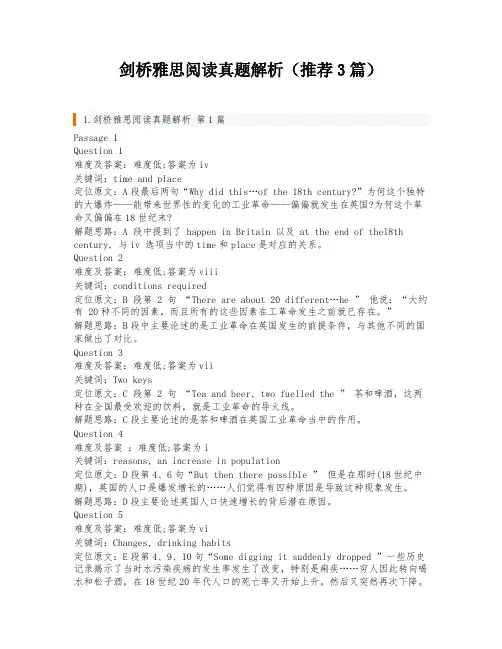
剑桥雅思阅读真题解析(推荐3篇)1.剑桥雅思阅读真题解析第1篇Passage 1Question 1难度及答案:难度低;答案为iv关键词:time and place定位原文:A段最后两句“Why did this…of the 18th century?”为何这个独特的大爆炸——能带来世界性的变化的工业革命——偏偏就发生在英国?为何这个革命又偏偏在18世纪末?解题思路:A 段中提到了 happen in Britain 以及 at the end of thel8th century, 与iv 选项当中的time和place是对应的关系。
Question 2难度及答案:难度低;答案为viii关键词:conditions required定位原文:B 段第 2 句“There are about 20 different…he ” 他说:“大约有 20种不同的因素,而且所有的这些因素在工革命发生之前就已存在。
”解题思路:B段中主要论述的是工业革命在英国发生的前提条件,与其他不同的国家做出了对比。
Question 3难度及答案:难度低;答案为vii关键词:Two keys定位原文:C 段第 2 句“Tea and beer, two fuelled the ” 茶和啤酒,这两种在全国最受欢迎的饮料,就是工业革命的导火线。
解题思路:C段主要论述的是茶和啤酒在英国工业革命当中的作用。
Question 4难度及答案:难度低;答案为i关键词:reasons, an increase in population定位原文:D段第4、6句“But then there possible ” 但是在那时(18世纪中期),英国的人口是爆发增长的……人们觉得有四种原因是导致这种现象发生。
解题思路:D段主要论述英国人口快速增长的背后潜在原因。
Question 5难度及答案:难度低;答案为vi关键词:Changes, drinking habits定位原文:E段第4、9、10句“Some digging it suddenly dropped ”一些历史记录揭示了当时水污染疾病的发生率发生了改变,特别是痢疾……穷人因此转向喝水和松子酒,在18世纪20年代人口的死亡率又开始上升。
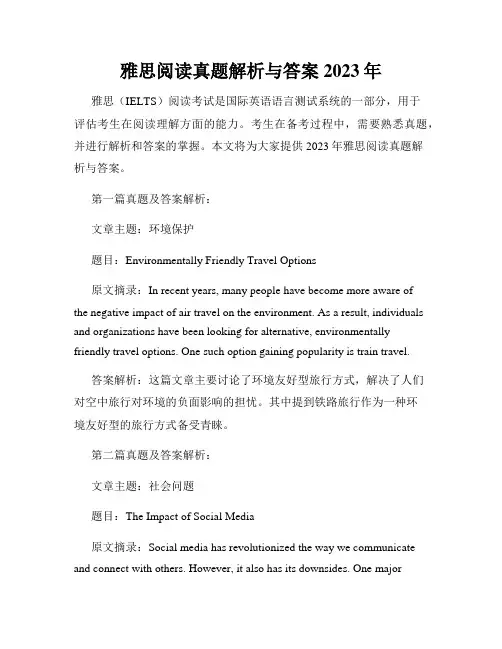
雅思阅读真题解析与答案2023年雅思(IELTS)阅读考试是国际英语语言测试系统的一部分,用于评估考生在阅读理解方面的能力。
考生在备考过程中,需要熟悉真题,并进行解析和答案的掌握。
本文将为大家提供2023年雅思阅读真题解析与答案。
第一篇真题及答案解析:文章主题:环境保护题目:Environmentally Friendly Travel Options原文摘录:In recent years, many people have become more aware ofthe negative impact of air travel on the environment. As a result, individuals and organizations have been looking for alternative, environmentallyfriendly travel options. One such option gaining popularity is train travel.答案解析:这篇文章主要讨论了环境友好型旅行方式,解决了人们对空中旅行对环境的负面影响的担忧。
其中提到铁路旅行作为一种环境友好型的旅行方式备受青睐。
第二篇真题及答案解析:文章主题:社会问题题目:The Impact of Social Media原文摘录:Social media has revolutionized the way we communicate and connect with others. However, it also has its downsides. One majorimpact of social media is the increased feeling of isolation and loneliness among individuals.答案解析:这篇文章主要探讨了社交媒体的影响。
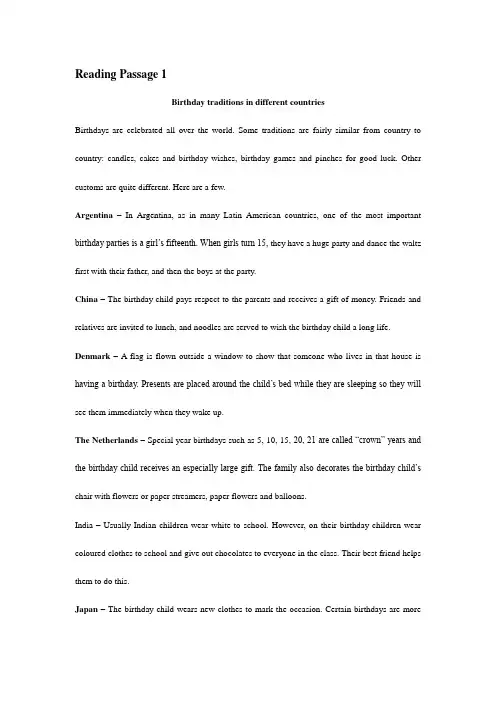
Reading Passage 1Birthday traditions in different countriesBirthdays are celebrated all over the world. Some traditions are fairly similar from country to country: candles, cakes and birthday wishes, birthday games and pinches for good luck. Other customs are quite different. Here are a few.Argentina–In Argentina, as in many Latin American countries, one of the most important birthday parties is a girl’s fifteenth. When girls turn 15, they have a huge party and dance the waltz first with their father, and then the boys at the party.China– The birthday child pays respect to the parents and receives a gift of money. Friends and relatives are invited to lunch, and noodles are served to wish the birthday child a long life. Denmark– A flag is flown outside a window to show that someone who lives in that house is having a birthday. Presents are placed around the child’s bed while they are sleeping so they will see them immediately when they wake up.The Netherlands– Special year birthdays such as 5, 10, 15, 20, 21 are called “crown” years and the birthday child receives an especially large gift. The family also decorates the birthday child’s chair with flowers or paper streamers, paper flowers and balloons.India – Usually Indian children wear white to school. However, on their birthday children wear coloured clothes to school and give out chocolates to everyone in the class. Their best friend helps them to do this.Japan– The birthday child wears new clothes to mark the occasion. Certain birthdays are moreimportant than others and these are celebrated with a visit to the local shrine. These are the third and seventh birthdays for girls and the fifth for boys.Questions 1-5Match the countries in the box with their descriptions.1 A country where longevity is celebrated by a special dish ________2 A country where candies are distributed among peers ________3 A country where the birthday is made known to the community ________4 A country where the household is full of birthday ornaments ________5 A country where religious worship is sometimes involved ________Reading Passage 2The American Revolution was not a revolution in the sense of a radical or total change. It was not a sudden and violent overturning of the political and social framework, such as later occurred in France and Russia, when both were already independent nations. Significant changes were ushered in, but they were not breathtaking. What happened was accelerate evolution rather than outright revolution. During the conflict itself people went on working and praying, marrying and playing. Most of them were not seriously disturbed by the actual fighting, and many of the more isolated communities scarcely knew that a war was on.America’s War of Independence heralded the birth of three modern nations. One was Canada, which received its first large influx of English-speaking population from the thousands of loyalists who fled there from the United States. Another was Australia, which became a penal colony now that America was no longer available for prisoners and debtors. The third newcomer – the United States – based itself squarely on republican principles.Yet even the political overturn was not so revolutionary as one might suppose. In some states, notably Connecticut and Rhode Island, the war largely ratified a colonial self-rule already existing. British officials, everywhere ousted, were replaced by a home-grown governing class, which promptly sought a local substitute for king and Parliament.Questions 6-106. Which of the following would be the best title for the passage?A The United States: An Isolated CommunityB Breathtaking Events During the American RevolutionC Canada and the American War of IndependenceD The American Revolution: Evolution Not Revolution7. In the first paragraph, what does the author suggest about the French and Russian Revolutions?A They were explosive and abrupt.B They were ineffective.C They involved only those people living in urban areas.D They led to the release of all political prisoners.8. In line 5, what does the author mean by “people went on working and praying, marrying and praying”?A More people got married than divorced.B The war created new jobs.C Life went on as usual.D People had more than enough leisure time.9. In the second paragraph, the author states that the colonies’ struggle for self-government preceded the creation of all of the following countries EXCEPTA CanadaB The United StatesC AustraliaD The United Kingdom10. It can be inferred from the passage that the loyalists who escaped to Canada wereA RussianB FrenchC BritishD AustralianReading Passage 3Puffery in AdvertisingA “Our coffee is loved by millions worldwide.” Do you often see this kind of advertising in yourcountry? Statements like these, that no-one can prove, are called puffery This is a term that has been developed for exaggerated claims that are made in advertising. Puffery is legal, even though such claims cannot be proved. In fact, puffery has been termed “a licence to lie”, as it is vague enough to be classed as opinion, an expression of the salesperson's evaluation of the product, rather than an objective statement.B Using puffery to raise awareness of products and to generate increased sales is a common advertising strategy. Goods and services are described in terms of superlatives, subjective opinions and exaggerations; various kinds of general claims are made, with no specific facts. So, why do some people worry about puffery? One of the concerns is whether consumers are misled by false advertising. Legal guidelines and government controls are required to prevent dishonest advertising. Companies understandably object to untruthful ads which give a competitor an unfair advantage in the market. These claims can be tested in the courts, and the decisions that are made help to make the boundary between acceptable puffery and illegal advertising.C Puffery is nothing new. It has been identified in documents dating from as long ago as the sixteenth century, when the notion of “caveat emptor” or “let the buyer beware” developed in business transactions. Although this initially applied to property deals, it came to be used more generally. This Latin term basically meant that anyone buying a product had a responsibility to check it carefully before payment. The seller did not need to take responsibility for defects (unless a problem had been deliberately concealed). In those days, of course, there was no notion of consumer rights or returns policies.D These days, however, if a company claims to sell the country's “best-loved” or “favourite” product, whether a brand of coffee or a make of car, this is held to be puffery, rather than an objective claim of market share. Similarly, the company does not have to produce proof that this claim is actually backed up by numbers or facts. In other words, claims such as “the world's best cup of coffee” are impossible to prove. They are also so exagge rated that it is expected that any consumer will understand how subjective they are. In effect, the company in question is said to be “boasting” rather than making objective claims. The claims are therefore not considered to be deceptive. In fact, puffery is often considered to add to the entertainment value of advertisements, especially television commercials.E On the other hand, a company that states their product is the “safest” or “cheapest” needs to show proof, because these claims can directly affect their competitors. Statements that are objective need to be backed up by proof or statistics, as consumer rights organisations can run tests to compare products such as washing machines and vacuum cleaners. They also investigate companies involved in insurance, finance, property, credit cards and other such services. Companies and salespeople should therefore be very careful when making factual statements about a product, or assertions regarding the quality of goods and services. In most developed countries, there is likely to be an official organisation which oversees the validity of advertising claims. In addition, there may be a government council with the authority to take legal action against companies that overstep the limit.F A primary function of advertising is to create product awareness. As consumers, we need toknow about competing products, so we can make informed decisions on which one to buy. While it is important that advertisers are monitored to ensure they do not mislead consumers, it can be argued that puffery is a good technique for raising awareness of new products that otherwise would go unnoticed in a crowded market. As long as there are effective ways of monitoring the claims of advertisers, to prevent deliberate deception in terms of safety or particular aspects of performance, it seems that most puffery is relatively harmless. Rather, it should be seen as an integral part of advertising, which most consumers can detect and laugh at rather than being misled.Questions 11-16The reading passage has six paragraphs, A-E Choose the correct heading for each paragraph from the list of headings below. Write the correct number, i-vii, next to the appropriate paragraph. There are more headings than paragraphs.11) Paragraph A12) Paragraph B13) Paragraph C14) Paragraph D15) Paragraph E16) Paragraph FQuestions 17- 23Do the following statements agree with the information given in the reading passage? Write TRUE if the statement agrees with the informationFALSE if the statement contradicts the informationNOT GIVEN if there is no information on this17.______ Some people argue against puffery because buyers might believe everything inadvertising.18.______ A court case is a way of determining whether advertising is deceptive or not.19.______ Puffery dates from the days of television commercials.20.______ ‘Caveat emptor' means that the seller has a responsibility for any problems withthe item sold21.______ ‘The world's best coffee' is an example of puffery22.______ ‘The world's safest chainsaw' is an example of puffery.23.______ People should carefully check prices before they buy goods.Questions 24-30Short AnswersAnswer the questions below. Choose NO MORE THAN THREE WORDS from the reading passage for each answer24.In addition to legal guidelines, what else is necessary to stop companies from usingdeceptive advertising? __________________25.When was puffery first used? __________________26.What does the writer say about claims such as ‘the world's best'? __________________.27.What does puffery contribute to television commercials? __________________28.What should objective statements be supported by? __________________29.What is the main purpose of advertising? To __________________30.Consumers need information on competing products to make……? ________________。
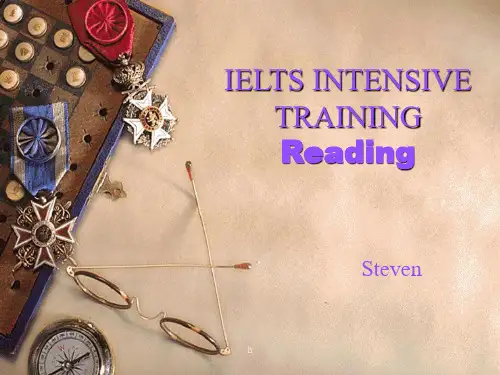
The birth of scientific EnglishWorld science is dominated today by a small number of languages, including Japanese, German and French, but it is English which is probably the most popular global language of science. This is not just because of the importance of English-speaking countries such as the USA in scientific research; the scientists of many non-English-speaking countries find that they need to write their research papers in English to reach a wide international audience. Given the prominence of scientific English today, it may seem surprising that no one really knew how to write science in English before the 17th century. Before that, Latin was regarded as the lingua franca for European intellectuals.The European Renaissance (c. 14th-16th century) is sometimes called the 'revival of learning', a time of renewed interest in the 'lost knowledge' of classical times. At the same time, however, scholars also began to test and extend this knowledge. The emergent nation states of Europe developed competitive interests in world exploration and the development of trade. Such expansion, which was to take the English language west to America and east to India, was supported by scientific developments such as the discovery of magnetism (and hence the invention of the compass), improvements in cartography and - perhaps the most important scientific revolution of them all - the new theories of astronomy and the movement of the Earth in relation to the planets and stars, developed by Copernicus (1473-1543).England was one of the first countries where scientists adopted and publicised Copernican ideas with enthusiasm. Some of these scholars, including two with interests in language -John Wall's and John Wilkins - helped Found the Royal Society in 1660 in order to promote empirical scientific research.Across Europe similar academies and societies arose, creating new national traditions of science. In the initial stages of the scientific revolution, most publications in the national languages were popular works, encyclopaedias, educational textbooks and translations.Original science was not done in English until the second half of the 17th century. For example, Newton published his mathematical treatise, known as the Principia, in Latin, but published his later work on the properties of light - Opticks - in English.There were several reasons why original science continued to be written in Latin. The first was simply a matter of audience. Latin was suitable for an international audience of scholars, whereas English reached a socially wider, but more local, audience. Hence, popular science was written in English.A second reason for writing in Latin may, perversely, have been a concern for secrecy. Open publication had dangers in putting into the public domain preliminary ideas which had not yet been fully exploited by their 'author' . This growing concern about intellectual properly rights was a feature of the period - it reflected both the humanist notion of the individual, rational scientist who invents and discovers through private intellectual labour, and the growing connection between original science and commercial exploitation. There was something of a social distinction between 'scholars and gentlemen' who understood Latin, and men of trade who lacked a classical education. And in the mid-17th century it was common practice for mathematicians to keep their discoveries and proofs secret, by writing them in cipher, in obscure languages, or in private messages deposited in a sealed box with the Royal Society. Some scientists might have felt more comfortable with Latin precisely because its audience, though intenational, was socially restricted. Doctors clung the most keenly to Latin as an 'insider language'.A third reason why the wriling of original science in English was delayed may have been to do with the linguistic inadequacy of English in the early modern period. English was not well equipped to deal with scientific argument. First, it lacked the necessary technical vocabulary. Second, it lacked the grammatical resources required to represent the world in an objective and impersonal way, and to discuss the relations, such as cause and effect, that might hold between complex and hypothetical entitiesFortunately, several members of the Royal Society possessed an interest in language and became engaged in various linguistic projects. Although a proposal in 1664 to establish a committee for improving the English language came to little, the society's members did a great deal to foster the publication of science in English and to encourage the development of a suitable writing style. Many members of the Royal Society also published monographs in English. One of the first was by Robert Hooke, the society's first curator of experiments, who described his experiments with microscopes in Micrographia (1665). This work is largely narrative in style, based on a transcript of oral demonstrations and lectures.In 1665 a new scientific journal, Philosophical Transactions, was inaugurated. Perhaps the first international English-language scientific journal, it encouraged a new genre of scientific writing, that of short, focused accounts of particular experiments.The 17th century was thus a formative period in the establishment of scientific English. In the following century much of this momentum was lost as German established itself as the leading European language of science. It is estimated that by the end of the 18th century 401 German scientific journals had been established as opposed to 96 in France and 50 in England. However, in the 19th century scientific English again enjoyed substantial lexical growth as the industrial revolution created the need for new technical vocabulary, and new, specialised, professional societies were instituted to promote and publish in the new disciplines.Choose NO MORE THAN TWO WORDS from the passage for each answer.Write your answers in boxes 28-34 on your answer sheet.In Europe, modern science emerged at the same time as the nation state. At first, the scientific language of choice remained 28____ It allowed scientists to communicate with other socially privileged thinkers while protecting their work from unwanted exploitation. Sometimes the desire to protect ideas seems to have been stronger than the desire to communicate them, particularly in the case of mathematicians and 29 ____In Britain, moreover, scientists worried that English had neither the 30 ____ nor the 31 ____ to express their ideas. This situation only changed after 1660 when scientists associated with the 32 ____ set about developing English. An early scientific journal fostered a new kind of writing based on short descriptions of specific experiments. Although English was then overtaken by 33 ____, it developed again in the (9th century as a direct result of the 34 ____.。
上海新航道学校雅思考试:雅思阅读的基础知识根据一些研究数据表明,雅思考试听说读写四项中量分最高的就是阅读。
所以,阅读单项是中国考生的一个提分秘籍。
然而,大家如果纵观众多的托福阅读真题,就会发现阅读其实是有渐难的趋势。
不仅表现在文章结构,文章主题上面,众所周知的一些雅思经典难题的出题频率也是越来越高。
就比如很多烤鸭所深恶痛绝的一种Matching题型——段落信息匹配题还有段落标题题的比重在上升,而传统的判断题数量有所减少。
那么,上述这些情况,文章变长,主题变偏,难题变多,就意味着雅思阅读的高分似乎没有以前那么容易了。
为了在雅思考场上收获一个满意的成绩,众烤鸭要做的第一件事就是要全面地了解雅思阅读的一些难点。
一、时间短。
一个小时六十分钟的考试时间烤鸭们要完成三篇长的学术型文章的阅读,回答四十道题目,并且完成填写答题纸的任务。
这样的紧张度使得一些考生产生无从下手的感觉。
更有一些学生反映,六十分钟仅仅只够完成两篇文章的,第三篇文章就只能靠运气。
造成这种现象,个人认为原因有二:其一是因为考生的阅读速度慢,加上陌生单词的阻碍,大大延缓的做题速度;其二,一些考生做题时没有培养成一种“果断”的做题态度,面对定位不到或者犹豫不定的题目时,往往会花费大笔时间在上面,这就造成了“为了一棵树放弃了整个树林”的效果。
二、生词多,结构复杂:雅思阅读的学术型很强,因为学术,所以生词多加之结构复杂也是自然的。
现在一般英语基础的考生有一个很大的问题就是分不清句子的主干部分,如果一个句子的主谓宾分不清,又加上一些学科性的词汇,就大大增加了难度。
三、题型比重略有改变:近两年阅读题型的变化也增加了很大的难度,偶尔会出现各类配对题占据四十道题目的半壁江山的状况。
配对题的题型特点决定了这种题目是个费时费力的任务,一般来说,想要正确解答出来,考生要能完全理解某些句子或者段落才可以。
四、乱序的几率增加:一般来说雅思阅读几大经典题型是普遍遵循顺序原则的,但是剑八剑九两本书中阅读题目的乱序情况要更加常见。
精选雅思阅读考试题及答案解析1. 题目:The Benefits of Bilingualism阅读理解:双语的好处解析:本文主要介绍了双语对个人和社会的好处。
首先,双语人士更容易找到工作,因为他们可以胜任双语工作岗位。
其次,双语人士在跨文化交流中更加得心应手,能够更好地理解不同文化之间的差异。
此外,双语人士在认知能力方面也具有优势,他们更善于处理信息和解决问题。
因此,研究第二语言对个人和社会发展都是有益的。
2. 题目:The Importance of Sleep阅读理解:睡眠的重要性解析:本文主要介绍了睡眠对身体和大脑的重要性。
睡眠对身体恢复和健康至关重要。
不良的睡眠惯可能导致多种健康问题,如肥胖、心脏疾病和免疫系统功能下降。
此外,睡眠对大脑功能也有重要影响。
充足的睡眠可以提高记忆力、注意力和创造力。
因此,为了保持身体和大脑的健康,我们应该重视睡眠。
3. 题目:The Impact of Social Media阅读理解:社交媒体的影响解析:本文主要探讨了社交媒体对个人和社会的影响。
社交媒体的普及改变了人们的沟通方式,使得信息传播更加迅速和广泛。
然而,社交媒体也带来了一些负面影响。
首先,过度使用社交媒体可能导致沉迷和时间浪费,影响个人的研究和工作。
其次,社交媒体也可能导致隐私泄露和网络欺凌等问题。
因此,人们需要理性使用社交媒体,注意维护个人信息安全和网络礼仪。
4. 题目:The Benefits of Exercise阅读理解:锻炼的好处解析:本文介绍了锻炼对身体和心理健康的好处。
锻炼可以帮助人们保持健康的体重、增强心肺功能和提高肌肉力量。
此外,锻炼还能改善心理健康,减少焦虑和抑郁症状,增强自信心和幸福感。
因此,每个人都应该定期进行适量的锻炼,以提高身体素质和生活质量。
5. 题目:The Impact of Climate Change阅读理解:气候变化的影响解析:本文主要讨论了气候变化对地球的影响。
Reading handout for lesson 1Part 1Part 1.1 : VocabularyChess Basketball Board games Sports Swimming Tennis CardsDancing Weightlifting Skiing Yoga Shopping Exercise Having fun Partying Karate Poker Puzzles Kick boxing Hiking Sharing ChattingPart 1.2: Practice3Part 2:Reading1.Read the following text and then look at the questions on the next page.The value of friendshipRecent research into the world of teenagers has suggested that they value friendship above everything else. Children aged between 12 and 15 were asked what was important to them. Their answers included possessions such as money and computer gadgets but also relationships with people. The teenagers questioned said that friends were the most important to them, more even than family, or boyfriends and girlfriends.We wanted to find out more about the results of this research so we asked our readers what they thought about the value of friendship. Here are some examples of what they said about their friends:Ben, 15: Every time I have a fight with my parents, I need some time on my own. But after that, the first thing I do is meet up with my friends. After playing football for a while, or skateboarding, I usually feel much happier again.Rory, 13: When I moved to a village in the countryside, I thought that it would be the end of my friendships. But my old friends have kept in touch and they come and visit in the holidays. There's a lake nearby, so we often go sailing, water-skiing or windsurfing. And I have made some new friends here too, at school, and since I joined the rugby club.Carlos, 11: Last year, I broke my arm on a skiing holiday. Unfortunately, it was my left arm and I am lefthanded. My school friends all helped and copied their notes for me.It seems that our readers value their friendships very highly. From what they told us, they spend a lot of time with their friends, just hanging out, or sharing hobbies and interests. They seem to need their friends for advice, help, chats, and for having fun. Clearly, friends make each other feel better. Looking at what our readers told us, the results of the recent research are not really surprising.2.Try to answer this question yourself first, before reading the explanation. Choose the best answer from the letters a-d.To teenagers, money is ...a)not important.b)as important as computer gadgets.c)as important as relationships with people.d)less important than friendships.3. Look at the questions in Exercise 4, without reading the answer options. Underline the question words (e.g. where, when, what) and the key words in each of the questions (1-3) and sentence stems (4-5).4. Now answer these multiple-choice questions. Choose the appropriate letter a, b, c or d.i.Why are Ben, Rory and Carlos mentioned in the article?A.They know why teenagers value friendship.B.They gave information about themselves.C.They read magazines,D.They are teenage boys.ii.Which of the following best describes Ben?A.He often has fights,B.He likes being alone.C.He is happier than his friends,D.He likes some sports.iii.What do we know about the lake that Rory visits?A.It is near the school。
雅思阅读真题附答案及解析雅思阅读是考试中相对较难的一部分,因此熟悉真题并且进行详细的答案解析是备考中不可或缺的一部分。
本文将为大家提供一些常见的雅思阅读真题,并附有详细的答案解析,希望能够帮助大家更好地备考雅思阅读。
第一篇:自然保护雅思阅读真题:自然保护是环保运动的一个重要方面。
自然保护旨在保护现有的生态系统,维护生物多样性和自然资源。
以下是一些常见的自然保护措施:1)建立自然保护区,2)限制猎捕和采集行为,3)推广可持续发展。
请根据以上内容回答以下问题:1. 自然保护的目标是什么?答案解析:自然保护的目标是保护现有的生态系统,维护生物多样性和自然资源。
2. 列举一些常见的自然保护措施。
答案解析:常见的自然保护措施包括建立自然保护区、限制猎捕和采集行为、推广可持续发展等。
雅思阅读真题:气候变化是当前全球性的环境问题。
以下是一些与气候变化相关的重要信息:1)二氧化碳排放是主要的温室气体,2)气温升高会导致海平面上升,3)气候变化会影响农业生产,4)可再生能源是应对气候变化的一种重要方法。
请根据以上内容回答以下问题:1. 什么是主要的温室气体?答案解析:主要的温室气体是二氧化碳。
2. 气温升高会导致哪个现象发生?答案解析:气温升高会导致海平面上升。
3. 气候变化对什么方面的影响比较大?答案解析:气候变化对农业生产有较大影响。
4. 应对气候变化的一种重要方法是什么?答案解析:应对气候变化的一种重要方法是利用可再生能源。
雅思阅读真题:科学技术在现代社会中起着重要的作用,对人类的生活产生了巨大的影响。
以下是一些与科学技术相关的重要信息:1)互联网的出现改变了信息传播的方式,2)生物技术可以用于治疗疾病,3)人工智能正在逐渐应用于各个领域,4)科学技术的发展带来了各种新的职业。
请根据以上内容回答以下问题:1. 互联网的出现改变了什么?答案解析:互联网的出现改变了信息传播的方式。
2. 生物技术可以用于解决什么问题?答案解析:生物技术可以用于治疗疾病。
雅思基础阅读
Reading Passage 1
Birthday traditions in different countries Birthdays are celebrated all over the world. Some traditions are fairly similar from country to country: candles, cakes and birthday wishes, birthday games and pinches for good luck. Other customs are quite different. Here are a few.
Argentina –In Argentina, as in many Latin American countries, one of the most important birthday parties is a girl’s fifteenth. When girls turn 15, they have a huge party and dance the waltz first with their father, and then the boys at the party.
China –The birthday child pays respect to the parents and receives a gift of money. Friends and relatives are invited to lunch, and noodles are served to wish the birthday child a long life. Denmark – A flag is flown outside a window to show that someone who lives in that house is having a birthday. Presents are placed around the child’s bed while they are sleeping so they
will see them immediately when they wake up. The Netherlands –Special year birthdays such as 5, 10, 15, 20, 21 are called “crown” years and the birthday child receives an especially large gift. The family also decorates the birthday child’s chair with flowers or paper streamers, paper flowers and balloons.
India –Usually Indian children wear white to school. However, on their birthday children wear coloured clothes to school and give out chocolates to everyone in the class. Their best friend helps them to do this.
Japan – The birthday child wears new clothes to mark the occasion. Certain birthdays are more important than others and these are celebrated with a visit to the local shrine. These are the third and seventh birthdays for girls and the fifth for boys.
Questions 1-5
Match the countries in the box with their descriptions.
1 A country where longevity is celebrated by a special dish ________
2 A country where candies are distributed among peers ________
3 A country where the birthday is made known to the community ________
4 A country where the household is full of birthday ornaments ________
5 A country where religious worship is sometimes involved ________
Reading Passage 2
The American Revolution was not a revolution in the sense of a radical or total change. It was not a sudden and violent
overturning of the political and social framework, such as later occurred in France and Russia, when both were already independent nations. Significant changes were ushered in, but they were not breathtaking. What happened was accelerate evolution rather than outright revolution. During the conflict itself people went on working and praying, marrying and playing. Most of them were not seriously disturbed by the actual fighting, and many of the more isolated communities scarcely knew that a war was on.
America’s War of Independence heralded the birth of three modern nations. One was Canada, which received its first large influx of English-speaking population from the thousands of loyalists who fled there from the United States. Another was Australia, which became a penal colony now that America was no longer available for prisoners and debtors. The third newcomer –the United States –based itself squarely on republican principles.。